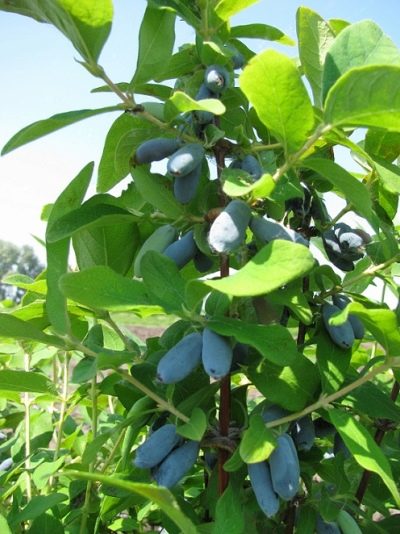
- Authors: All-Russian Research Institute of Plant Industry named after N.I. Vavilova
- Growth type: medium-sized
- Description of the bush: wide, slightly spreading
- Bush height, m: 1,5
- Escapes: upright
- Leaves: petioled, bright green, elliptical, whole-edged
- Flowers: steamy, white, fragrant
- Fruit size: large
- Fruit weight, g: until 3
- Fruit shape: elongated oval
Avacha is a variety of honeysuckle bred by Russian breeders. Avacha berries are versatile and suitable both for fresh consumption and for making compote. Avacha bushes will feel comfortable when grown in the northwest regions.
Description of the variety
The Avacha bush has an average vigor of growth, it is wide, slightly spreading, reaches a height of 1.5 m. The branches grow in the form of an arc, curved from the trunk, the shoots are erect. Leaves develop in the shape of an ellipse, are bright green in color. The flowers are white, fragrant, and grow in pairs.
Fruit characteristics
Avach berries are large, weighing up to 3 g, elongated-oval in shape. The skin of the fruit is blue with a waxy bloom, the pulp is violet-red.
Taste qualities
The berries taste pleasant, sour-sweet, juicy, suitable for making desserts, have a strawberry aroma.
Ripening and fruiting
The first berries are formed on the bush in the second year after planting. Fruiting begins in mid-June, which is typical for mid-ripening varieties.
Yield
This is a high-yielding variety: on average, you can get 2-2.5 kg of berries from one bush.

Self-fertility and the need for pollinators
The Avacha variety is not capable of pollinating on its own, therefore, pollinators should be planted next to it, that is, varieties with the same ripening period. Suitable, for example, Cinderella, Malvina, Tomichka.
Growing and care
The presented variety will give a good harvest if planted in moisture-absorbing loamy or sandy loam soil, the acidity does not matter much. The site should be located in the sun or partial shade. Planting is recommended in the autumn. Before planting, the soil should be mixed with compost, and between the seedlings during group planting, keep a distance of 1-1.5 m.To stimulate the formation of strong shoots at the base of the bush, you need to reduce the length of the shoots of the planted seedling by two-thirds. Follow-up care includes the following points.
Watering
The Avacha variety is moisture-loving, which means that it should be watered often and a lot. To retain moisture, mulch the tree circle with bark or straw. Especially often the bush needs high-quality moisture during the dry period.
Pruning
Formative pruning is carried out every 3-4 years, but sanitary pruning is required every year - in late autumn. When forming a bush, cut off branches growing in the wrong direction and intersecting shoots. At the same time, try to leave at least three buds on the branches. When sanitizing pruning, remove old, damaged, diseased branches. Do not over-prune as this crop tends to grow rapidly.
Top dressing
In the first couple of years, the bush does not need fertilizers, since it has enough of those substances that were added to the soil during planting.From the third year of life, additional food is required every year. To stimulate flowering, gardeners use formulations with a low nitrogen content. Meat and bone meal or fish meal is also good. The filling of the prepared mixtures should be carried out at a depth of 15-20 cm, that is, at the location of the bulk of the root system.
The presented variety has a high level of winter hardiness, and therefore it does not need shelter for the winter.


Disease and pest resistance
Avacha is characterized by excellent immunity against diseases and insects, but in extremely rare cases it can be affected by aphids. At the same time, young bushes are more vulnerable to the pest. If the plant is attacked by aphids, then the colony can be washed off with the pressure of water or the bush can be treated with tinctures of garlic, tobacco and pepper. From purchased products, the effectiveness in the fight against insects was proved by Aktellik, Konfidor, Iskra.

































































